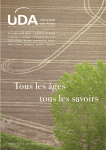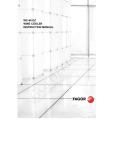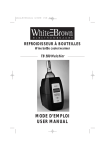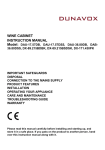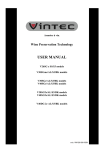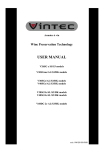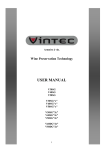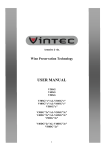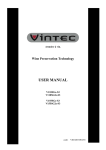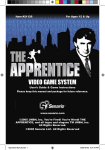Download Climadiff Multi-Purpose and Aging Wine Cellars Owner`s manual
Transcript
OWNERS MANUAL Multi-Purpose and Aging Wine Cellars US 115 Volts – 60 Hz Version AC 1 TABLE OF CONTENTS: THANK YOU……………………………………….…….4. LEGAL ………………………………………..…..…. ..4. SAFETY PRECAUTIONS..………..…………….…….4. • Aeration/ Odor Control • Relative Humidity • UV Exposure • Solid Door (Option) • Glass Window Door (Option) IDENTIFICATION .....……………………..……..…… 5. WINE CELLAR – PART IDENTIFICATION………… 5. INSTALLATION……………………………………..…..6. TEMPERATURE CONTROL…………..………………………..…11 • Unpacking • Installation Area • Wine Cellar – Display • Free Standing Installation • “Multi Purpose Cellar” – Display • Leveling • “Aging” Cellar – Display • Ambient Temperature • Temperature Selection • Electrical Connection • Temp. Adjustments – Aging Cellar • Temp. Adjustments – Multi Cellar CELLARS – GENERAL CONTROL FACTORS..….8 • Aging Temperatures • Serving Temperatures • Thermal Dynamics- Illustration • Humidity • Internal Temps – Illustration • Odors/ Ventilation • Temperature Indicator • Vibrations • Relative Humidity • Light CLIMADIFF WINE CELLARS – TYPES………….....9 CELLAR OPERATION………………..……….14 MAINTANENCE………………………..………16 • Cleaning • Aging Cellars • Changing Charcoal Filters • Multi-Purpose Cellars • Extended Stop • Conditioning Cellars • Defrost Condensate • Transporting the Cellar CLIMADIFF WINE CELLARS – QUALITIES…….… 9 • Reliability and Safety • Winterization Kit (Low Temperature Control) • Types of Bottles • Vibration Controls • Wiine Bottle Shelves SHELVING OPTIONS…………………….…..18 2 Table of Contents …Continued LOADING METHOD ...............................18 TROUBLESHOOTING and FAQ’s...........22 • Details on Capacities • Electricity • Loading • Temperature • Maximum Load Compliance • Compressor operation • Winter System (heating) • Relative Humidity..................23 • Water in the Cellar • Odors in the Cellar • Noise from the Cellar • Shelf Sagging • Power Outages......................24 • Error Codes INTERNAL LIGHTING..............................20 WINE CELLAR REGISTER.........................20 PROPER SERVING TEMPERATURES........21 MATURATION SCHEDULE......................21 DISPOSAL...............................................2 1 SPARE PARTS.........................................22 3 CLIMADIFF WINE CELLARS THANK YOU Thank you for deciding to entrust your wine collection to a "Climadiff" Group cellar. To optimize the installation and the use of your new wine cellar, please keep and read this owner's manual carefully. LEGAL Climadiff disclaims any warranty on its wine cellar for any use other than that described in the guide, as well as for any intervention made by a third party not approved by Climadiff (or its appointed dealers). The names and brands indicated in this guide are copyrighted. This guide contains proprietary information; unauthorized reproduction of all or any part of the content contained herein is strictly prohibited, unless expressly agreed to in writing, by Climadiff. Climadiff S.A. reserves the right to change the information contained in the operating manual guide without notice. SAFETY PRECAUTIONS BEFORE USING YOUR WINE CELLAR FOR THE FIRST TIME, CAREFULLY READ THIS USER GUIDE. WHEN USING THIS APPLIANCE, ALWAYS EXERCISE BASIC SAFETY PRECAUTIONS TO AVOID RISK OF ANY HAZARDS AND PERSONAL INJURY. BE SURE TO KEEP THIS GUIDE FOR FUTURE REFERENCE , OR TO TRANSFER TO A NEW OWNER. WARNING: If the wine cabinet was tilted during its transport or placement, it is important to leave the wine cellar in the vertical position for 24 hours prior to connecting the power. It is essential for the lubricating oil to descend and accumulate in the compressor before initial operation. FAILURE to do so could cause the cooling system to break down and void the compressor warranty. WARNING: DO NOT tilt the unit forward to lean on the bottom edge of the door. This will cause irreversible damage to the door, and will not be covered under the warranty protection! All units are packed and secured to the shipping pallet using two screws through the rear plate and a “spacer” located under the door to prevent movement during transport. • • • • • • • • • • • • • Make sure that your electrical voltage and power rates correspond to the indications on the name/data plate on your wine cellar. The cellar must be plugged into a grounded 3 prong electrical outlet. Cord repairs or incorrect connections will lead to dangerous conditions. Have your electrical installation checked by a professional if you are in doubt. If the power cord is damaged at any time, have it replaced by an approved technical centre, the dealer, or an authorized service representative. An electrical device must only be repaired by qualified personnel. Unqualified repairs may lead to serious dangers for the user. For safety reasons, do not use an electrical extension cord. Do not connect the cellar to a multi-use electrical adapter. Always disconnect the cellar before performing any servicing or cleaning operation (disconnect the power plug or the corresponding circuit breaker depending on the model). In case liquid is accidentally spilled (broken bottle or other) on the electrical elements (motor or other), immediately disconnect the power plug. If your cellar is damaged or has suffered from any kind of incident (overvoltage due to lightning, flooding, fire), it may prove dangerous. Disconnect the power plug and have the device checked by an approved professional technician. Do not use your cellar outdoors. Do not expose it to atmospheric agents (humidity, moist, extreme temperatures etc.). This cellar is designed to conserve only wine. Do not place food inside it. This device is not designed to be used by people (including children) with reduced physical, sensory or intellectual capacity or by people lacking experience or knowledge unless they are supervised, or have received instructions on how to use the device by a person responsible for their safety. This cellar is designed for residential use. Never pull on the power cord. Never pull on the cord to disconnect the plug. Always grip the plug connected at the wall outlet and unplug. 4 • • • • • • • • Make sure the power cord is protected from any possible damage. To avoid any risk of fire, electric shock or injury, do not immerse the power cord, the plug or the device in water or any other liquid. The power cord must not come in contact with sharp edges, or any source of heat. Do not operate the appliance in the presence of explosives and/or flammable fumes. Always remove all bottles before moving this appliance. This wine cellar should not be recessed or built-in an enclosed cabinet. It is designed for freestanding installation only. Keep children away from using with the cellar door and shelving, or playing with the display. Danger: Risk of child entrapment. Before discarding an old wine cellar makes sure to remove the door(s). Leave the shelves in place so that children may not easily climb inside. Follow your local laws and by-laws for safely disposing refrigerated appliances Climadiff disclaims any responsibility for damages resulting from the failure to comply with the connection or utilization instructions. IDENTIFICATION To identify your wine cellar, refer to the name/data plate inside the cabinet. LEGEND 1. 2. 3. 4. 5. 6. 7. 8. 9. 10. 11. Label border Brand logo Type - Reference Production no. Serial number Date of manufacture (coded) Climate class Voltage – Frequency Amperage External fuse value Lighting power 5 12. 13. 14. 15. 16. 17. 18. 19. 20. 21. 22. 23. Heating system's power (if > 100 W) Defrosting system's power Refrigerant gas and quantity Insulating agent's chemical formula Maximum pressure Minimum pressure Note : read the user instructions Note : conformity to the certificates Note : device to be recycled according to the regulations in force Note : conformity to the directive in force Manufacturer's note Acronym specific to the refrigerant gas used IMPORTANT: WHEN YOU ARE LOOKING FOR INFORMATION OR TECHNICAL ASSISTANCE, ALWAYS SPECIFY THE REFERENCE, SERIAL NUMBER, AND THE PRODUCTION NUMBER PRINTED ON THE NAME/DATA PLATE. WINE CELLAR - PART IDENTIFICATION 1 2 3 4 5 6 7 8 9 10 11 12 13 14 15 16 17 18 Lighting Wine bottle tray Name/data plate Height adjustable feet (x 2) 2 castor wheels Power cable with contact pin Temperature control system and thermometer Light switch ON/OFFswitch Lock Door Evaporator (cold wall) Shelf fastening slots Drainage hole Seal Condensate gutter Shelf support Activated charcoal filter INSTALLATION UNPACKING WARNING: DO NOT tilt the unit forward to lean on the bottom edge of the door. This will cause irreversible damage to the door, and will not be covered under the warranty agreement! Depending on the models, remove the transport pallet on which your wine cellar is placed by removing the two screws securing it to the frame at the rear of the device. Remove all the wedging (under the door for example) and protection elements present inside. 6 INSTALLATION AREA Make sure to place your wine cellar in a suitable and stable location, away from any heat source, protected from direct sunlight, and protected from low/extreme temperatures. Make sure that the surface area where the cellar will be placed is flat and strong enough to support it when fully loaded (weight of the cellar plus bottles loaded). Leveling legs in the front of your cellar can be adjusted by turning them clockwise to raise the cellar or counterclockwise to lower the cellar. The cellar door will close easier when the leveling legs are extended. Do not place your cellar in the open air and be careful to maintain a minimum space of 7”- 8” between the top of the cabinet and the ceiling located above it. Note: the defrosting water recovery tank located at the back of the cabinet near the compressor could overflow under extreme ambient conditions. FOR THIS REASON, WE RECOMMEND CHOOSING THE APPROPRIATE KIND OF FLOOR SURFACE AND ROOM FOR YOUR CELLAR SO THAT HUMIDITY OR THE POSSIBLE FORMATION OF WATER DOES NOT CAUSE ANY DAMAGE . FREE STANDING INSTALLATION Be sure to leave a space of at least 5 in. (127 mm) between the wall and the back of your wine cellar to allow the free circulation of air. This device is not designed to be embedded or built-in any cabinet. WARNING: Make sure that the surface area where you are going to install the device can support its weight and the weight of its contents when full. LEVELING Adjustable feet under the two front corners of the wine cellar (depending on the model) can be used to find the proper level. The adjustments are made by screwing (or unscrewing) the adjustable feet. A wedge can be employed to find the horizontal level (use of a bubble-level is recommended). This will avoid any movement (due to instability), vibrations or generation of noise and will also ensure the proper closure of the door. Leaning the cellar slightly backward, to allow gravity- flow for the condensation at the bottom of the unit – helping to prevent the formation of various deposits (scales). AMBIENT TEMPERATURES EXTREME AMBIENT TEMPERATURES (HOT AND COLD) CAN ALTER THE CELLAR'S PERFORMANCE, CAUSING EXCESSIVE ENERGY CONSUMPTION AND DISRUPTION TO THE DESIRED TEMPERATURES. 7 IMPORTANT: BE CAREFUL TO NOT EXCEED THE FOLLOWING MINIMUM AND MAXIMUM VALUES RETAINED FOR OPTIMUM OPERATION OF YOUR CELLAR: Wine cellar W IT HO UT winter system (Not available after purchase as on optional system): • Glass door : +50°F and +86°F (10 C and 30 C) • Solid door : +50°F and +95°F (10 C and 35 C) o o o o Wine cellar W IT H winter system: • Glass door : +32°F and +86°F (0 C and 30 C) • Solid door : +32°F and +95°F (0 C and 35 C) o o o o IMPORTANT: IF YOU WANT TO USE YOUR AGING WINE CELLAR AS A SERVICING CELLAR AND IF YOU WANT TO o REACH A TEMPERATURE OF OVER 55°F ( 13 C), PLEASE PAY ATTENTION TO RESPECT THESE AMBIENT TEMPERATURES: • Glass door : ambient temperature between 53°F and 86°F (12 C and 30 C) • Solid door : ambient temperature between 53°F and 95°F (12 C and 35 C) o o o o ELECTRICAL CONNECTION WARNING: If the wine cabinet was tilted during its transport or placement, it is important to leave the wine cellar in the vertical position for 24 hours before connecting the power. It is essential for the lubricating oil to descend and accumulate in the compressor before initial operation. FAILURE to do so could cause the cooling system to break down and void the compressor warranty. Refer to the safety instructions mentioned at the beginning of this guide. Your wine cellar is equipped with a 3 - pronged grounded cord (115 V/60 Hz - cUL standard - single phase power network). It must be properly connected to a grounded wall outlet with a minimum of 15 A services. A loose fit between the AC outlet (receptacle) and plug may cause overheating and a distortion of the plug. Contact qualified electrician to replace any loose or worn outlets. WINE CELLARS – GENERAL CONTROL FACTORS Wine needs a combination of many conditions in order to properly develop as it matures. It is a complex process. Temperature is of critical importance. It is necessary to make the distinction between aging or preservation temperatures and serving temperatures, so that your wines are properly maintained for their purpose. o o Aging Temperature: designates a range of temperatures between 50°F (10 C) and 57°F (14 C); ideally, around o 54°F (12 C), whatever the type of wine to be preserved and aged. But, more than the levels, it is the consistency of the temperature during the aging process which will allow the wine to fully blossom. Therefore, it is important to avoid any sudden thermal shocks. Serving Temperature : serving wine at its appropriate temperature is crucial to enjoying its full potential. When served too cold, the aroma of the wine is anaesthetized and its character hidden. When served too warm, it will become unbalanced by too much alcohol. The serving temperature is the range of temperatures at which a wine o o should be served and consumed: from 43°F (6 C) for "liqueurs" up to 64°F (18 C) for red tannic vintage wines. Adherence to, and maintenance of the following conditions is crucial to your investment. 8 Humidity: corks must be kept consistently moist in order to remain hermetic. At a persistent relative humidity < 50%, the cork dries out and the wine will oxidize. At a persistent relative humidity >80 %, mildew and mould may appear, and labels may start to peel. Odors/ Ventilation: wine “breathes” through its cork. In an odorous environ, wine will denature. Vibrations: vibrations cause wine “fatigue” and disturb its maturation. disruption. It is crucial to keep the wine free from Light: light increases the oxidation-reduction potential of wine, accelerating its aging. This is why it is important to shelter wine from the harmful effects of UV rays. . CLIMADIFF WINE CELLARS - TYPES Climadiff, the wine cellar specialists, have designed various types of cabinets to suit all purposes: AGING CELLAR (Homogeneous Temperature): designed for a stable aging environment, these cellars offer a consistent and appropriate temperature, proper humidity and odor control, as well as protection against unwanted vibration and excessive UV light. These cellars are engineered to distribute a constant temperature, providing a homogeneous average without any mechanical air mixing. Therefore, your wines are kept free of humidity and temperature fluctuations. The Aging Cellars closely mimic the conditions of natural wine cellars which favor the optimum requirements for the proper aging of "grand cru" wines. MULTI- PURPOSE CELLAR (multi- temperature): Natural stratification allows for a staged choice of temperature ranges; chambering for reds, preservation (aging), as well as cooling for ready to serve whites and Champagnes: multi-purpose multi-area management! Ready to serve red wines are stored at about 64°F (±~2°F) in the top section of the cabinet, while the aging area is centered around a temperature of 55°F (±~2°F) in the middle section, while the ready to serve whites and Champagnes are kept in the lower area of the cabinet at 46°F (±~ 2°F). CONDITIONING CELLAR (Serving temperature) : with these cabinets, your wines are kept at their optimum temperature – you will be able to enjoy your "grand cru's" at precisely the right temperature to fully appreciate your wines. CLIMADIFF WINE CELLARS - QUALITIES RELIABILITY AND SAFETY All Climadiff wine cabinets are manufactured with highest quality components. The technologies of the various systems used conform to the highest reliability and safety standards. The value of their contents deserves the greatest respect. “WINTERIZATION KIT” (LOW TEMPERATURE PROTECTION) To optimize the security of a constant ideal temperature inside your Climadiff wine cellar, Climadiff outfits the cellar with a “Winter Kit” (depending on the model). The temperature inside your wine cellar is automatically regulated with o respect to the ambient temperature. Should the outside ambient temperature fall below 32°F (0 C) (without freezing); requiring a rise in temperature (to maintain the internal preset), a heating feature ensures that there is no harmful effects to your vintages from a disruptive or sudden temperature “bounce”. As soon as the temperature in the bottom o of your wine cabinet drops below the minimum preset temperature (~43°F (6 C) ), the winter system will activate. The heating resistance warms the entire cabinet very slowly, smoothly and silently. So, your wines remain under optimum preservation conditions! 9 Should your unit not include this feature, and your installation would benefit from this devise, please contact the after sales service of your distributor to install this option (kit and installation costs extra). IMPORTANT: ONLY THE COMPRESSOR AND REFRIGERATION SYSTEM GENERATES NOISE . HEATING IS DONE SILENTLY BY THROUGH HEATING RESISTANCE . VIBRATION CONTROL Wine does not like to be disturbed. It especially dreads vibrations. This is why your wine cellars’ compressor is mounted on special shock absorbers called "silent blocks". Likewise, the inside tank is insulated from the body by a thick layer of polyurethane foam which has the added benefit of also absorbing vibrations. Depending on the model, the wine bottle shelves are made of solid wood and absorb vibrations far better than metal. On some models, the wine bottle shelves supports are also equipped with rubber pads to further absorb any vibrations. AERATION/ ODOR CONTROL Your Climadiff wine cellar is equipped with a permanent air refreshing system filtered by an activated charcoal filter. It is recommended to replace this filter once a year (may be ordered from a dealer). For replacement instruction, refer to the "maintenance” chapter and to the wine cellar diagram to see where the filter is located. RELATIVE HUMIDITY Average internal humidity is approximately 60% (±10%). This is the average relative humidity range recommended to keep the cork of your bottles sufficiently moist to maintain the flexibility and elasticity required to keep it hermetic to liquids, while still letting your wine breathe. Except in extreme ambient conditions, the humidity level should be self maintaining. Should there be a humidity deficit; an “add-water” symbol will appear on units with a display. In other units, moistened lava rocks may be employed to control and moderate internal humidity – the condition should be checked periodically. U.V. EXPOSURE Warning: Ultra-Violet light accelerates the oxidation-reduction process and therefore the premature aging of wine. Always protect your investment by minimizing the exposure to these harmful conditions. SOLID DOOR (OPTION) Your Climadiff wine cellar can be equipped with a solid door; providing 100% protection from light exposure. GLASS WINDOW DOOR (OPTION) Windowed door options feature a high UV protection to filter ultra violet rays. Units with the LED soft illumination have an insignificant emission for the time in use (automatic shut-off’s available on some models). Protection from direct sunlight is essential when choosing a location for your glass-door cellar. 10 TEMPERATURE CONTROL WINE CELLAR DISPLAY Fig. 1 Fig. 2 Fig. 3 MULTI-PURPOSE CELLAR - DISPLAY Failure alert pictogram Top area temperature Heating resistance's operating pictogram Average relative humidity indicator Central area temperature Compressor's operating pictogram Bottom area temperature Error code Add water indicator “AGING” CELLAR - DISPLAY Failure alert pictogram Heating resistance's operating pictogram Average relative humidity indicator Compressor's operating pictogram Error code Temperature Add water indicator 11 To start or stop the wine cellar, press the button (above the lit display) for 5 seconds. During the start-up of the wine cellar or after an electrical power cut-off, the control system is set by a calibration process. During this process, the display and the selection buttons are lit and the alert pictogram (triangle with exclamation point) flashes. The process can take from 10 to 60 seconds. When the process is terminated, the display and buttons return to normal. The temperature inside the wine cellar is automatically controlled by the electronic control system (figure 1-1) The system is preset in the factory and operates automatically. The basic parameters were defined for an average o o central area temperature of 54°F or 12°C (+/- 36 F (2 C). TEMPERATURE SELECTION If a new setting or an adaptation of the preservation temperature is considered to be necessary: • Press the buttons for more than 5 seconds (fig. 2) As soon as the aforementioned control value starts flashing on the screen, the temperature can be changed. To lower the inside temperature : • • Press the button to decrease the temperature by degree (°C / °F) (fig. 3) • Press the • Do not forget to validate the change by pressing the buttons for more than 5 seconds to record the new temperature (fig. 2) buttons for more than 5 seconds (fig. 2) To raise the inside temperature : • Press the • Press the • Do not forget to validate the change by pressing the button to increase the temperature by degree (°C / °F) (fig. 3) buttons for more than 5 seconds to record the new temperature (fig. 2) buttons for more than 5 seconds (fig. 2) TEMPERTURE ADJUSTMENT - AGING CELLAR The inside temperature is homogenized and the factory setting is 54°F (12°C). The internal temperature can be set anywhere between 46°F and 64°F (8 °C to 18°C ), allowing you to have an ideal aging temperature at 54°F (12°C), or a dedicated service temperature for the your reds, whites, rosé, champagnes, etc. IMPORTANT : IN THE CASE YOU WOULD LIKE TO HAVE A TEMPERATURE OF +64°F (18°C ) AND THAT YOUR WINE CELLAR HAVE A GLASS DOOR, THE AMBIENT TEMPERATURE MUST BE IMPERATIVELY HIGHER THAN + 59°F ( 15°C ) 12 Simultaneously press the Up and Down arrows for 5 seconds; a beep sounds. The temperature value already selected flashes. Using the Up and Down arrows, select the new temperature value desired. A beep signals each change. Simultaneously press the Up and Down arrows for 5 seconds. A beep sounds. The changes are accepted, and the cellar returns to display the current temperature in the cabinet. The temperatures will then gradually increase or decrease according to the desired setting. TEMPERATURE ADJUSTMENT - MULTI-PURPOSE CELLAR Ideal temperature levels are preprogrammed from the factory. The preset levels give a temperature range of 64°F to 46°F (18 °C to 8°C ) from the top to bottom of the cellar. The graduated stratospheric effect inside the cabinet means that the area in the middle of the cabinet will then be 55°F (or 13°C) – perfect for aging. You can adjust the overall temperature RANGE by a few degrees (up or down) as desired. Possible settings are: TOP of temperature range (top of cabinet), followed by the BOTTOM of the temperature range (Bottom of Cabinet): 63°F to 45°F (17°C to 7°C); 64°F to 46°F (18°C to 8°C); 66°F to 48°F (19°C to 9°C). Simultaneously press the Up and Down arrows for 5 seconds; a beep sounds. The temperature value already selected flashes. Using the Up and Down arrows, select the new temperature value desired. A beep signals each change. Simultaneously press the Up and Down arrows for 5 seconds. A beep sounds. The changes are accepted, and the cellar returns to display the current temperature in the cabinet. The temperatures will then gradually increase or decrease according to the desired setting. Note: Some Fahrenheit models will switch to a Celsius setting for temperature setting adjustments. The temperature for the top of the cabinet will be blink at the bottom of the display, and pressing the “up” or “down” buttons will give preset options of 17°,18°, or 20° (remember - to set the new temperature selection you must simultaneously press the Up and Down arrows for 5 seconds (as mentioned above) . By setting the top-of-cabinet temperature in this way, the rest of the cabinet will then automatically adjust accordingly (display will return to F°). 13 CELLAR OPERATION In the traditional natural cellar, temperature and humidity remain fairly consistent – any subtle changes from one season to another, are relatively small and very gradual. Your Climadiff cellar mechanically reproduces these optimum conditions for your wines in the convenience of your home. The precise operation of the cellar’s temperature is monitored by thermostats located strategically within the cabinet. Small temperature variations can be observed in the air of the wine cellars cabinet, as the cooling system operates on a cycle. This is normal - temperatures randomly read by placing a thermometer at various levels in the cabinet do not precisely reflect the temperature of your wine. A critical mass is created by the bottles in the cabinet - a wine cellar filled with 200 bottles represents a potential thermal mass of approximately 573 lbs or 260 kgs (1 wine bottle = 2.86 lbs or 1.3 kgs.). This means that the impact of small ambient temperature variations (in the air around the bottles) is minimized due to the thermal inertia created through the thermal mass. Thermal inertia is the tendency of your bottles to keep their initial temperature for a comparatively long duration - despite these small temperature fluctuations within the cellar. This is the same principle which prevents the chilling of a bottle by simply placing it in the refrigerator for an hour. Actually, the conductivity of wine drops 0.15% per degree (°F) (on average) with increasing temperature - this also contributes to the stabilization of the wine temperature within the cabinet. As illustrated below, temperature fluctuations of 3.6 °F (2°C) have no noticeable effect on the thermal equilibrium of your wines – they remain perfectly preserved. THERMAL DYNAMICS - ILLUSTRATION Compressor stopped Compressor running Compressor stopped Temperatures and relative humidity of the air at time T following the operating cycle Air temperature and average temperature in the bottle 14 INTERNAL CELLAR TEMPERATURES - ILLUSTRATION Top part, ideal for conditioning red wines to the serving temperature Central part, ideal for preservation. "Important: prestigious champagne vintages should be enjoyed around 54°F" (12°C) The entire wine cellar is dedicated to the aging of your wines or, at your choice, to put a the right servicing temperature the wine color of your choice (single adjustable temperature between +46°F(8°C)and+64°F (18°C) Bottom part, to have mellow white wines and champagnes at the tasting temperature. TEMPERATURE INDICATOR The electronic temperature displays the average temperature(s) in the cabinet. As previously illustrated, the compressor's operating cycles do not interfere with the constant average temperature of the wine in the bottles. If you place your own thermometer inside the appliance, it may not display the same value indicated on the display. The electronic regulation system automatically calculates average wine temperature using a temperature/ time based algorithmic calculation. The liquid's inertia compared to air is based on a factor of 1 to 10 and your wine cellar itself will correct for it (a o o variation outside the bottle of more than 34 F (2°C) is evidenced by a variation of only 32.18 F (0.2°C) in the bottle's contents). If a significant temperature difference is noticed between the set temperature and the displayed temperature, please be aware that having the door open for a prolonged period can affect the internal air temperature, until corrected by the cellar over the next cycles(s). RELATIVE HUMIDITY Your Climadiff wine cellar automatically controls the relative humidity in the cabinet. The combination of the circulation of filtered ambient air loaded with humidity in the cabinet, the phenomenon of condensation linked to the cabinet's operation, and the surface area of the inner steel walls coated with a paint of large particle size offers your wines the ideal ambient conditions. Average internal humidity is 60% (±10%). This is the average relative humidity range recommended to keep the cork of your bottles sufficiently moist to maintain the flexibility and elasticity required to keep it hermetic to liquids, while still letting your wine breathe. Humidity levels are normally automatic and self- maintaining. Under exceptionally dry ambient conditions, there may be a drop in humidity below 40%. In this case units with a display will show the “addwater” symbol. To do this, simply add water to the “condensate reservoir” in the bottom (of some models - NOTE: Water will freely flow out the drainage hole to an open evaporation tray in the back of the unit, which will flood if overfilled!) In units not equipped with a reservoir, you can place a wet sand bin in the device or else a bowl of pure water (or tap water provided it does not have a strong smell). In other units, lava rocks are provided to control and moderate internal humidity – simply keep them moist and positioned in the bottom rear of the unit. 15 Note: Wait a few days after you have started operating the wine cellar for the first time so that the ideal average relative humidity (55 to 70%) is stabilized in the cabinet. Frost may form in the bottom of the cellar - this is a normal phenomenon which will disappear when the natural inertia level of the wine cellar is reached. The indicated relative humidity value corresponds to a short-term average which is regularly updated. If the displayed relative humidity is momentarily a little lower, it may correct itself within a short period (corks will not be adversely affected). The following values may be observed on the display : • 45% appears if the relative humidity at the cabinet's centre is between 40% and 50% • 55% appears if the relative humidity at the cabinet's centre is between 50 % and 60 % • 65 % appears if the relative humidity at the cabinet's centre is between 60 % and 70 % • 75% appears if the relative humidity at the cabinet's centre is above 70 % This “Add Water” pictogram appears if the persistent relative humidity is below 40%. Please check if there is water in the defrosting gutter. If not, please add water inside. (see the figure under heading "extended stop"). MAINTENANCE CLEANING Normally the wine cabinet does not require any specific maintenance except that the activated charcoal filter should be replaced once a year. However, if cleaning is considered necessary, disconnect the power supply and clean the cabinet inside and outside using a damp cloth with a mixture of soft detergent and warm water (never use solvents or any abrasive agents). Rinse with pure water and let dry before reconnecting. CHARCOAL FILTER The activated charcoal filter must be replaced once a year. The filter is the black round plastic part which filters the air entering your wine cellar. You can see it from the inside as well as from the outside. It is located in the upper right corner of the wine cellar. Simply remove it from the inside by carefully pulling it out. To purchase a new filter(s), contact your retailer or call 1.877.AGE.WINE (243.9463) 16 EXTENDED STOP Completely disconnect the cellar. Be sure to remove the bottles. Clean and dry the inside of the tank and especially the condensate water recovery drain located in the bottom part of the cabinet. Condensate drainage Condensate reservoir DEFROST CONDENSATE The cabinet is equipped with an automatic defrost cycle. When the cooling cycle is finished, the refrigerated parts of the cabinet are defrosted automatically. The accumulated water is channelled through the drainage hole into an evaporation tray (located at the back of the cabinet close to the compressor). The heat from the compressor then evaporates the water from the tray that will be drawn up by the charcoal filter, returning humidity to the cabinet. TRANSPORTING THE CELLAR The cabinet should be transported wherever possible in its original package to avoid any risk of damage. If you should transport the wine cellar laying down, it must be protected and laid on the side where the compressor's loading nozzle is facing downward. In the example, you would lay the cellar down to the right (from the rear), so the nozzle points down. Always remember to remove shelving and lock the door before tilting or moving the cellar. ANY TECHNICAL INTERVENTION PERFORMED BY AN UNAPPROVED PERSON MAY VOID THE WARRANTY. For any other type of maintenance, contact the after-sales service of your retailer. 17 SHELVING OPTIONS TYPES OF BOTTLES An example of multi-type 750 ml Burgundy and Bordeaux wine bottle placement: Be very careful when multi-stacking bottles of varying types (especially heavily tapered bottles, as they can “rock” and destabilize the stack. WINE BOTTLE SHELVES “BGN” Wooden (hardwood) shelves Each type of wine cellar has its own type of wine bottle shelf. Note that there is no ideal storage arrangement. A collection of wine bottles is rich when it is varied. It is up to you to arrange the storage capacity of your wine cellar according to your collection. Note: Wooden shelves are natural materials prone to slight warping. This effect is rectified when they are loaded. Additional wine bottle shelves may be purchased from your retailer or by calling: 1.877.AGE.WINE(243.9463) Sliding BGN Shelves: The rolling shelves make access to the back row very easy as they have a 75% roll out capability. If multi-stacking on a rolling shelf be sure to only use similar, appropriately stable bottles that will be supported when rolled out. Obviously, bottles can not be stacked to the walls on upper layers – so capacity will be limited the higher the bottles are stacked. Three layers is the maximum height for safety. Reversible wine bottle shelves The "Collector“ wine bottle shelf is a reversible Bordeaux or Burgundy wine bottle shelf invented by Climadiff to allow making an efficient, reliable and practical arrangement choice. One side has imprints for "Bordeaux 25 oz. (750 ml) type bottles", while the other side has imprints for "Burgundy 25 oz. (750 ml) type bottles". An etched sign of the type of bottle appears on each side of the shelf indicating the type of bottles to use according to your collection. 18 Sliding reversible wine bottle shelves Depending on the model, the wine cellar is delivered with one or more sliding wine bottle shelves. You may purchase additional wine bottle shelves, as well as sliding rails by placing an order with the after-sales service of your retailer or calling our Toll-free # 1.877.AGE.WINE (243.9463). Note: Adding additional shelving will decrease the total bottle capacity of the wine cellar accordingly. Example: The standard 265 bottle model includes 5 shelves, and will accommodate up to 13 sliding shelves, but total capacity will drop to 197 bottles. The standard 315 bottle model includes 6 shelves, and will accommodate up to 16 sliding shelves, but total capacity will drop to 236 bottles LOADING METHOD DETAILS ON CAPACITIES Capacity indications assigned to the various Climadiff wine cellar models are given as a guideline only. These will help you make your choice according to your desires and your available space. These capacities are based on a standard 25 oz. (750 ml) Bordeaux style bottle. In reality, you will probably be collecting bottles of different shapes and sizes. For practical reasons, it is likely that you will fill your wine cellar with a smaller number of bottles than the maximum number it can hold. For example, if a wine cellar is loaded only with Burgundy wine bottles, there will be approximately 30% fewer bottles than the initial quantity calculated for Bordeaux bottles. Another important effect on loading is the number of wine bottle shelves. Each additional wine bottle shelf is usually equivalent to the loss of one full bottle layer. Adding more shelves increases the functionality of the wine cellar at the cost of its capacity: you will have to decide between the degree of capacity versus practicality that best suits your needs. LOADING The desired temperature after the wine cellar starts running will only be reached after a few hours of operation. We recommend running your wine cellar empty for a few hours before you start loading it. Your wine cellar is delivered with one or more wine bottle shelves made of metal or wood according to the model : • Place the supports in appropriate lateral notches inside the cabinet to fit your needs. Make sure that the supports are inserted correctly in the notches (only a slight pressure is necessary to put the angle iron in place and make sure that it holds properly). • Start by loading the lower part of your wine cellar. • Then simply stack the bottles with their bases facing backward in the back row and conversely for the front row. The wine bottle shelves are to be arranged according to the size of your wine cellar and the shapes of your wine bottles. IMPORTANT: MAKE SURE THAT THE BOTTLES DO NOT COME IN CONTACT WITH THE CABINET'S BACK WALL. This will interfere with the bottle temperature, condensation and cause a disturbance in the air circulation. If you have a large number of bottles, we recommend that you load 40 bottles at a time and then let the device run for 12 hours before you load another 40 bottles. Repeat this operation as many times as necessary in order to create a thermal mass in your wine cellar. 19 Additional wine bottle shelves are available for purchase from the after-sales service of your retailer or calling our Toll-free# 1.877.AGE.WINE (243.9463). MAXIMUM LOAD COMPLIANCE The load limit per shelf must not be exceeded. Do not exceed the designated maximum capacity The wine bottle shelves are to be arranged according to the size of your wine cellar and the shapes of your wine bottles. Fixed wine bottle shelves : 385 lbs (or 175 kgs) - approximately 130 bottles, 7 levels of 25 oz. (750 ml) Sliding wine bottle shelves : 55 lbs (or 25 kgs) (approximately 15 bottles) Warning : do not obstruct the activated charcoal filter when stacking/ loading shelves INTERNAL LIGHTING (OPTIONAL DEPENDING ON MODEL) The soft lighting in the cellar can be switched on by pressing the button located on the control panel (symbolized by the "light bulb" pictogram). It offers you the option of illuminating your wine cellar while maintaining the preservation conditions of your wines (low emissivity LED). IMPORTANT : When turning off the lighting, please note that because of the “soft-light fading” feature - there is a slight delay in the response time. The delay is a function of the feature: continually pushing the button in rapid succession may cause the light to remain on – in which case the unit may need to be turned off and on again. On some wine cellars, the interior lights will automatically switch off if left on too long. Note : The inside lighting button located on the control panel is inactive for devices not equipped with this function WINE CELLAR REGISTER The wine cellar register is an original Climadiff innovation. The cellar registration (or prestigious "grand cru" wine table) can be found on the inside of the cellar door (based on model and excluding glass doors). Use chalk to record information about the characteristics of your collection, or give a list of your prestigious "grand cru’s". Note: Use only chalk to write on the wine cellar register. To erase information, use a slightly moistened cloth or sponge. Never use a detergent or abrasive materials. 20 PROPER SERVING TEMPERATURES Opinions can vary, and factors like ambient temperature can be factored, however many can sommeliers will agree on the following : Wines Prestigious Bordeaux wines – Reds Serving temperature Prestigious Burgundy wines – Reds Prestigious dry white crus 59-61°F 57-61°F Light, young, full flavoured reds Provence rosés, primeur wines (futures) 52-54°F 50-54°F Dry whites and red "local" wines "Local" white wines 50-54°F 46-50°F Champagnes Liquoreux wines 45-46°F 43°F 61-63°F Cellar selection could never been more well rounded, and all can be properly accommodated in the Climadiff MultiPurpose cellar! MATURATION SCHEDULE The time required for various vintages to attain their optimum maturity can vary widely. The table below will give to you an idea about the number of years your bottles will need to reach the peak of their maturity. MATURITY TABLE (IN YEARS) APPELLATIONS Alsace Alsace grand crus Beaujolais (crus) Beaujolais primeur Bergerac Bordeaux Burgundy Cahors Cotes de Provence Cote Rotie, Hermitage Burgundy grand crus Bordeaux grand crus Jurancon mellow, liquoreux Jurancon dry Languedoc Loire Loire mellow, liquoreux Macon Montbazillac Savoie Rhone Valley Yellow wine White Rosé 1-4 8 - 12 2-3 2-3 5 1-2 8 8 - 10 8 -10 6 -10 2-4 1-2 5 - 10 10 - 15 2-3 6-8 1-2 2 20 Red 1-4 1-2 3-4 3-4 7 5 - 10 2-5 8 - 15 10 -15 10 - 15 2-4 5 - 12 1-2 2–4 4–8 DISPOSAL The symbol of the crossed out trash container on the cabinet indicates that this product should be, at the end of its useful life, treated separately from general domestic waste. 21 It should therefore be taken to an appropriate collection centre for electrical and/or electronic refrigerated appliances. The user is responsible for making sure that the appliance is given to the appropriate recycling agency. For more detailed information regarding recycling, please contact your local office of the environment or the store in which the appliance was bought. DANGER - Risk of child entrapment. Before you throw away your old wine cellar, take off the doors. Leave the shelves in place so that children cannot easily climb inside. Follow your local laws and by-laws for safely disposing refrigerated appliances. SPARE PARTS The spare parts necessary to the reparation of this appliance will be kept available for 7 years. Troubleshooting – faq’s Before contacting the service department, please refer to the possible solutions suggested below: ELECTRICITY My wine cellar does not work : 1. 2. 3. 4. 5. Is the cellar is properly plugged into a grounded wall AC outlet? Make sure there hasn’t been a power outage No power from the outlet : check your circuit breaker or test the outlet. The plug is not correctly plugged in. If your wine cellar is in an unheated room, refer to the section "WINTERIZING KIT". TEMPERATURE My wine cellar is too cold: Select a higher temperature – see TEMPERATURE CONTROL My wine cellar is not cold enough: Select a lower temperature – see TEMPERATURE CONTROL The temperature in my wine cellar varies slightly: 1. Temperature variations can correspond to the compressor's operating cycles – see TEMPERATURE CONTROL. 2. If the temperature read in your wine cellar is different from that usually observed, (it does not follow a consistent fluctuation over several hours), please contact the after-sales service of your product. COMPRESSOR OPERATION The Compressor is not running: 1. 2. 3. 4. Be sure that it is in fact not running – the compressor operation cannot often be heard if there is background noise – try eliminating any background noise interference. Is the electrical cord connected to a grounded AC outlet? – see TROUBLESHOOTING Electricity. Is the ambient temperature of your room very low? If the temperature is between 34°F to 55°F the heating feature may be running silently (if your model features the winterization kit) – see TEMPERATURE CONTROL. If the compressor is still not running, contact the after-sales service The Compressor is continually running: 22 1. 2. 3. Check to see if door is completely closed Check the door gasket for proper seal Door may have been opened frequently or for extended period of time. If no cold effect is observed, call the after-sales service. THE WINTER SYSTEM (HEATING) DOES NOT SEEM TO BE OPERATING The system operates only if the inside temperature in the lower part of your wine cellar is below the set temperature. RELATIVE HUMIDITY What should be the average relative humidity in my wine cellar? 1. 2. The ideal average relative humidity should be around 60% (+/- 10 pts) ; this varies as a function of the compressor's operating cycles. Just like for the average temperature, it is the average relative humidity value which counts. Depending on your geographical zone and the relative humidity in the air, water may have to be added. In temperate countries, the relative humidity contained in the air is between 50 and 80 %. Therefore, it is not necessary to add water, but this should be regularly checked. The average relative humidity of my wine cellar remains persistently below 50 % : (Relative humidity will normally fluctuate ) 1. 2. 3. 4. Check whether the activated charcoal filter is too old or obstructed. Make sure that your hygrometer is operating correctly. The average relative humidity allows corks to preserve their elasticity. Values will sometimes fluctuate - but the average will ensure the maintenance of moisture for the corks. If the humidity remains too low, add more water – see CELLAR OPERATION: Relative Humidity The relative humidity in my wine cellar remains persistently above 80 %. (Relative humidity will normally fluctuate) : 1. 2. 3. 4. Check whether the activated charcoal filter is too old or obstructed. Make sure that your hygrometer is operating correctly. Drain any excessive water from the reservoir at the bottom of the unit – check to see if the drain is plugged or if the unit is not level enough to allow for proper drainage Moderate other hydration techniques employed – see CELLAR OPERATION: Relative Humidity. WATER IN THE BOTTOM OF THE CELLAR 1. 2. 3. This is not detrimental to your wine. Is the wine cellar level? Does it lean forward too far preventing proper draining? Is the drain pipe clogged? ODOURS IN THE CELLAR 1. 2. Replace the activated charcoal filter every year – operating with a clogged or dirty filter may cause odors to permeate porous materials like corks. Replacements can be ordered from your retailer or call our toll-free # 1.877.AGE.WINE. The activated charcoal filter must be free of obstructions, like a shelf or bottles to operate properly. NOISE FROM THE CELLAR 1. 2. The compressor, when running, will generate a certain degree of noise. If the noise seems excessive, check the rubber shock absorbers (silent blocks) on the bottom of the compressor to see if they are in place. Also check to see that the compressor is free from obstruction/contact with any other element. If “rattling” sounds are heard: these arise from the circulation of the gas in the pipes and are a normal result of the proper operation of your wine cellar. SHELF SAGGING 23 1. Make sure that the maximum load capacity is not exceeded. POWER OUTAGES MOST POWER OUTAGES ARE RESOLVED IN A SHORT TIME. BECAUSE THE UNITS ARE WELL INSULATED, AN OUTAGE OF 1 OR 2 HOURS WILL NOT ADVERSELY AFFECT THE TEMPERATURES WITHIN THE CABINET. IN ORDER TO PROTECT THE WINES DURING AN OUTAGE, DO NOT OPEN THE DOOR (UNLESS REQUIRED). FOR EXTENDED OUTAGES, TAKE STEPS TO PROTECT YOUR WINE FROM EXTREME TEMPERATURE SWINGS. ONLY EXTENDED EXPOSURE OF YOUR WINES TO THESE ABNORMAL CONDITIONS MIGHT PROVE DETRIMENTAL TO THEM. ERROR CODES In spite of high manufacturing standards, quality process control checks and the best quality parts used in all Climadiff Wine Cellars, the possibility of a technical problem can arise. In order to easily detect any problems, error codes will be shown on the display. W E REMIND YOU THAT ANY ATTEMPTED REPAIR BY A NON QUALIFIED PERSON MAY CAUSE RISKS OF SERIOUS INJURIES AND MAY VOID THE WARRANTY OF THIS WINE CELLAR. ALSO IT WOULD RELEASE THE MANUFACTURER AND/OR ITS DISTRIBUTORS FROM ANY FURTHER WARRANTY OBLIGATION. You will need to communicate to the technician which code is displayed; Error codes: E01 :P1 E02 :P2 E03 :P3 E09 E010 P1 = Temperature sensor located at the bottom. It regulates the compressor and the winter heater if this option is installed. P2 = Temperature sensor located at the top. It regulates the heater on the top only for MULTI TEMPERATURE cellars. The top heater is always built in to the Multi-Purpose cellars. P3 = Hygrometry sensor. It regulates the humidifier if humidifier is built in (based on model) E01, E02 and E03 means that the sensor is defective or the connection between the PCB of the power module and the sensor is loose. E09 means that the safety thermostat switched off the cooling (and heating) because the temperature inside the cabinet was too low. • When the temperature inside the bottom of the cabinet increases to ~43°F or to the set point, the compressor will switch on again. • The signal E09 will flash (along with the triangular symbol) until the main supply cord is unplugged (keep unplugged for 2-3 minutes). After plugging in the main supply cord, the E09 and the flashing triangular symbol will disappear. • If the temperature is still too low at the bottom of the cabinet the error code and the triangle will appear again. E10 means that the communication cable on the PCB of the power module or on the PCB of the display is loose or the communication cable is defective. 24 The sensors of P1, P2, P3 and the safety thermostat are pushed in from the back into tubes which are foamed in the side walls. IMPORTANT: The sensors have to be completely pushed into the tube end (as deep as possible). Glossary Preservation: Preservation conditions allow wines which are mature to maintain their qualities for a time. Aging : The climatic enclosure is designed to mimic natural underground wine cellars with specific adherence to factors such as light and temperature regulation, humidity control, and an absence of vibration and odors. Serving temperature: The wine cellar permanently maintains bottles at the right serving temperature, for example : Prestigious red cru : 64 to 66°F, Light red : 57 to 61°F, White, rosés and vintage champagnes : 50 to 54°F ; Liqueurs : 46 to 50°F Winter System: A heating system, which allows positioning your wine cellar in an unheated area (but above freezing) “Comfort” wine bottle shelf: Made from hard wood (water repellent tropical wood) ; they are designed to ensure an optimal, ergonomic and safe storage of bottles. Collector® wine bottle shelf: Made of hardwood; their imprints are specifically designed for an optimal accessibility and secure storage. They are reversible (Front side : Bordeaux / Back side : Burgundy, Loire Valley, etc.). Sliding wine bottle shelf : Mounted on easy-slide rails, they facilitate almost 75% accessibility to a second row. Wine cellar register : The original Climadiff innovation which allows you to manage your collection by writing about it with a piece of chalk on the inside counter door of the cabinet. Climadiff S.A., Les Docks – Atrium 10.5, BP 56224, 13567 Marseille Cedex 2, France. Tel: + 33 (0) 4.96.11.52.52 Fax: +33 (0)4. 91.35.36 [email protected] www.climadiff.com 25

























